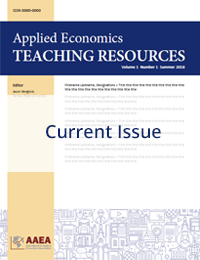Teaching and Educational Methods
Training Underrepresented Students via an Interdisciplinary Food Safety Outreach Program
Jeta Rudi-Polloshka(a), Amanda Lathrop(b), Karen Cannon(c) and Erin Krier(d)
Michigan State University (a), California Polytechnic State University (b), K.J. Cannon Consulting (c), Allan Hancock College (d)
JEL Codes: A12, A21, A22, A23
Keywords: Diversity, food safety, outreach, students
First Published Online: December 13, 2023
Volume 5, Issue 4
Abstract
Many higher education institutions strive to provide applied training to their students, such as by encouraging internships and including experiential learning activities in courses. This article summarizes students’ participation in an outreach program as an alternative form of receiving applied training while attending college. Funded by a governmental grant and implemented by faculty and students, an interdisciplinary food safety outreach program provided a learn-by-doing opportunity to students. This article summarizes students’ participation in the project under the leadership of faculty and concludes with a brief list of best practices for involving students in similar future projects.
References
Arnade, C., L. Calvin, and F. Kuchler. 2009. “Consumer Response to a Food Safety Shock: The 2006 Food-Borne Illness Outbreak of E-Coli O157:H7 Linked to Spinach.” Applied Economic Perspectives and Policy 31(4):734–750.
Association of Food and Drug Officials. 2023. “PSA Grower Training Course”. PSA Grower training course – Association of Food and Drug Officials (afdo.org)
Barr, K., E. Irlbeck, and C. Akers. 2012. “Salmonella and the Media: A Comparative Analysis of Coverage of the 2008 Salmonella Outbreak in Jalapenos and the 2009 Salmonella Outbreak in Peanut Products.” Journal of Applied Communications 96(1):29–41.
Boland, M.A., C.J. Kopka, K.L. Jacobs, C. Berner, B.C. Briggeman, M. Elliott, D. Friend, P. Kenkel, G. McKee, F. Olson, J.L. Park, W. Secor, K. Schweiss, H. Scott, and T. Worley. 2022. “Extension Programming During a Pandemic: The Cooperative Director Foundations Program.” Applied Economics Teaching Resources 4(2):14–28.
Calley, B.B., C. Meyers, and C. Gibson. 2019. “A Comparative Content Analysis of News Stories and Press Releases During the 2015 Blue Bell Ice Cream Recall.” Journal of Applied Communications 103(3):1–20.
Canales, E., J. Silva, and J. Anderson. 2022. “The Adoption of Food Safety Practices and the Implications of Regulation for Small Scale Farms.” The Journal of Extension 60(2):1–8.
Centers for Disease Control and Prevention. 2018. “Burden of Foodborne Illness: Findings.” https://www.cdc.gov/foodborneburden/2011-foodborne-estimates.html
Centers for Disease Control and Prevention. 2022. “How Food Gets Contaminated—The Food Production Chain.” https://www.cdc.gov/foodsafety/production-chain.html
Conner, K.N., E. Sikora, J. Koebernick, and M. Zaccaron. 2022. “Interdisciplinary Team Addresses Cotton Leafroll Dwarf Virus in Alabama.” The Journal of Extension 60(2):1–3.
Cuffey, J., W. Li, W. Sawadgo, and A. Rabinowitz. 2022. “Cross-Hedging in the Classroom: Engaging Students in Developing Scholarly Extension Output.” Applied Economics Teaching Resource 4(2):59–68.
FoodSafety.gov. 2022. “People at Risk: Those with Weakened Immune Systems.” https://www.foodsafety.gov/people-at-risk/people-with-weakened-immune-systems
Freedman, D. 2021. “Educating the Next Generation of Food Safety Leaders.” Food Safety Magazine. https://www.food-safety.com/articles/7477-educating-the-next-generation-of-food-safety-leaders.
Gibson, C., E. Irlbeck, C. Meyers, C. Akers, and P. Price. 2019. “An Investigation of Agricultural Crisis Communications via Social Media.” Journal of Applied Communications 103(4):1–19. https://doi.org/10.4148/1051-0834.2279
Irlbeck, E., C. Akers, M. Baker, S. Burris, and M. Brashears. 2014. “A Case Study and Framing Analysis of the 2008 Salmonella Outbreak.” Journal of Applied Communications 98(2):65–77. https://doi.org/10.4148/1051-0834.1079
Ivins, T., K. Copenhaver, and A. Koclanes. 2017. "Adult transitional theory and transfer shock in higher education: practices from the literature", Reference Services Review 45(2):244-257.
Knobloch, N. A. 2003. “Is Experiential Learning Authentic?” Journal of Agricultural Education 44(4):22–34. https://doi.org/10.5032/jae.2003.04022
Liu, Y., and W. Zhang. 2022. “Nurturing International Graduate Students for a More Diversified and Inclusive Extension Workforce.” Applied Economics Teaching Resource 4(2):45–58.
Marshall, T.L., A.D. Hagerman, H.E. Shear, K.H. Burdine, and B.B.R. Jablonski. 2022. “Building Up the Next Generation of Extension Specialists.” Applied Economics Teaching Resource 4(3):1–11.
Nabwiire, L., A.M. Shaw, G.R. Nonnecke, D.D. Minner, E. Johnsen, and L.E. Petersen. 2022. “Cultural Sensitivity: A Requirement When Developing Food Safety Interventions” The Journal of Extension, 60(1): Article 4. https://doi.org/10.34068/joe.60.01.04
Office of Governor Gavin Newsom. 2020. Governor Gavin Newsom Issues Stay at Home Order. https://www.gov.ca.gov/2020/03/19/governor-gavin-newsom-issues-stay-at-home-order/
Opat, K., H. Magness, and E. Irlbeck. 2018. “Blue Bell’s Facebook Posts and Responses During the 2015 Listeria Crisis: A Case Study.” Journal of Applied Communications 102(4):1–16. https://doi.org/10.4148/1051-0834.2232
Riley, J.M. 2020. “Hedging with Futures: An Experiential Learning Game” Applied Economics Teaching Resource 2(2):30-37.
Schmit, T.M., R. Stamm, and R.M. Severson. 2022. “Engaged Learning: Linking Course Instruction and Extension Programming.” Applied Economics Teaching Resource 4(2):69–83.
Stevenson, C.D. 2015. “Occupational Analysis of the Present and Future Food Safety Workforces.” Food Protection Trends. Mar-Apr-15Stevenson.pdf (foodprotection.org).
U.S. Department of Agriculture, Economic Research Service. 2022. “Estimates of Foodborne Illnesses.” https://www.ers.usda.gov/data-products/cost-estimates-of-foodborne-illnesses.aspx
U.S. Department of Agriculture, National Institute of Food and Agriculture. 2021. “Food Safety Outreach Program.” https://www.nifa.usda.gov/food-safety-outreach-program
U.S. Department of Agriculture, National Institute of Food and Agriculture. 2022. “Supporting Underserved California Leafy-Green Producers’ FSMA Compliance, Through Interdisciplinary Food Safety, Communication and Marketing Training.” Current Research Information System. https://cris.nifa.usda.gov/cgi-bin/starfinder/0?path=fastlink1.txt&id=anon&pass=&search=R=85170&format=WEBLINK
U.S. Food and Drug Administration. FSMA Compliance Dates. https://www.fda.gov/food/food-safety-modernization-act-fsma/fsma-compliance-dates.
Williford, B.D., L.D. Edgar, J.K. Rucker, and S. Estes. 2016. “Literature Themes from Five Decades of Agricultural Communications Publications.” Journal of Applied Communications 100(1):64–75. https://doi.org/10.4148/1051-0834.1022.
Articles in this issue
Agribusiness Study Abroad Programs and Their Potential for Fostering a More Inclusive Climate
Timothy A. Delbridge
Awareness and Usage of Extension and Outreach Programs
Julian M. Worley, William B. Banks, William Secor, Benjamin L. Campbell
Does Exam Formatting Affect Grades in Online Agricultural Marketing Courses?
Juan Pachon, Bachir Kassas, John Lai, Gulcan Onel
Training Underrepresented Students via an Interdisciplinary Food Safety Outreach Program
Jeta Rudi-Polloshka, Amanda Lathrop, Karen Cannon and Erin Krier
Market Power in the U.S. Peanut Industry
Yuliya V. Bolotova
To Rebuild or Not to Rebuild When Disaster Hits
Jada M. Thompson, Misti D. Sharp, and Jonathan C. Walton


